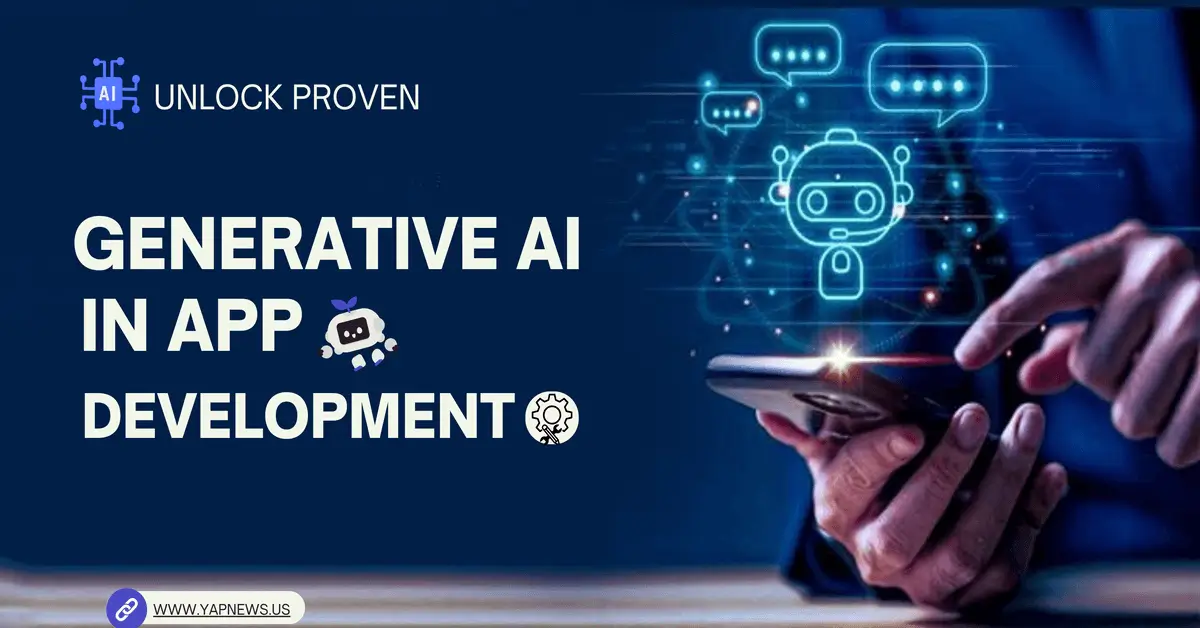The app development world is on the verge of a big change. 80% of smartphones are expected to run AI apps locally by 2025, says IDC. This means there’s a huge need for apps that are smart, personal, and can predict what users want.
Gartner’s Hype Cycle shows AI agents are key in app making. The market is set to grow to $221.9B by 2034, with an 18.6% CAGR. This shows how important it is to use generative AI in app development.
Developers who use generative AI app development will lead this change. They’ll make apps that are smart, easy to use, and fun.
Key Takeaways
- The growing importance of AI in app development, with 80% of smartphones expected to run AI apps locally by 2025.
- The projected market growth to $221.9B by 2034, driven by the adoption of generative AI.
- The increasing demand for intelligent, personalized, and predictive user experiences.
- The role of Gartner’s Hype Cycle in tracking the adoption of AI agents in app development.
- The need for developers to adopt generative AI app development techniques to stay ahead.
The Current Landscape of App Development in 2025
In 2025, the app development world is changing fast. Generative AI and multimodal AI apps are leading this change. They make app development better and change how we use apps.
Key Market Statistics and Growth Projections
The global AI market is growing fast. This growth is because more people and businesses are using AI.
Market Growth to $221.9B by 2034 (18.6% CAGR)
Market research shows the global AI market will hit $221.9 billion by 2034. It will grow at a rate of 18.6% each year. This shows AI’s big role in many fields, including app development.
| Market Segment | 2024 | 2034 | CAGR |
|---|---|---|---|
| AI in App Development | $50B | $221.9B | 18.6% |
| Low-Code AI Tools | $10B | $50B | 17.5% |
| Multimodal AI Apps | $5B | $30B | 19.6% |
The table shows how different AI parts in app development will grow. More money going into low-code AI tools and multimodal AI apps means apps will be more efficient and fun to use.
As the industry keeps changing, using generative AI and multimodal AI will lead to new ideas. This will help developers make apps that are smarter and easier for users.
Generative AI in App Development 2025: A Paradigm Shift
As we enter 2025, generative AI is changing app development forever. The industry is on the verge of a big change. Generative AI will change how we develop apps, make them better for users, and spark new ideas.
How Generative AI is Transforming Development Practices
Generative AI is making development faster by automating simple tasks. It also makes code better and lets developers work on harder, more creative projects. AI UI design is getting more popular, making apps easier to use. This trend will keep growing in 2025, with more AI-driven design tools available.
Gartner Hype Cycle on AI Agents and Development Tools
Gartner’s Hype Cycle shows AI agents and tools are key in the industry. Their report says AI is becoming central to software development. This change is because we need faster, better ways to develop software.
The Hype Cycle says AI agents are at the peak of expectations. Development tools are close behind. As
“AI will change the way we develop software, making it faster, cheaper, and more reliable.”
This shows how generative AI can truly change the industry.
7 Revolutionary Trends Driving AI-Powered App Development
In 2025, AI is changing app development in big ways. These changes help developers do more and make apps better. They also change how apps are made and used.
Generative UI: Creating Dynamic User Interfaces
Generative UI is changing how we make user interfaces. AI helps create interfaces that change and adapt. This makes apps more personal and fun to use.
AI-First Application Architecture
The move to AI-first application architecture is changing app structure. It makes apps smart and flexible from the start. This is key for apps that grow and change.
Multimodal AI Integration for Enhanced Functionality
Multimodal AI lets apps talk to users in many ways. This includes voice, text, and pictures. It makes apps more useful and easy to use.
Responsible AI Development Frameworks
Using responsible AI development frameworks is getting more important. These frameworks help make sure AI apps are fair and safe. They focus on being open, fair, and secure.
The last three trends are about using AI for testing, adding AI analytics, and making AI models better. These trends are shaping the future of app development. They give developers new ways to make cool apps.
Essential Generative AI Tools Every Developer Should Master
Generative AI is changing how we make apps. Developers need to learn the best tools to stay ahead. These tools make work easier and help create new, exciting apps.
GitHub Copilot: Revolutionizing Code Completion
GitHub Copilot uses AI to help write code. It suggests code and finishes parts, saving time and making code better.
Key Features and Integration Options
GitHub Copilot works well with many coding tools. It has cool features like:
- Context-aware code suggestions
- Support for many programming languages
- Integration with GitHub for better teamwork
Cursor: The AI-Enhanced Code Editor for Modern Developers
Cursor is becoming a favorite among coders. It uses AI to make coding easier and more fun. It’s a must-have for today’s developers.
Why Developers Are Switching to Cursor (With Sign-up Link)
Cursor is attracting coders with its:
- Advanced AI code suggestions
- Easy-to-use interface
- Smooth integration with current coding setups
Try Cursor here and see the future of coding.
| Tool | Key Features | Benefits |
|---|---|---|
| GitHub Copilot | AI-powered code completion, context-aware suggestions | Reduced development time, improved code quality |
| Cursor | AI-enhanced code editor, intuitive interface | Streamlined coding process, enhanced productivity |
5 High-Impact Use Cases for Generative AI in Development
Generative AI has changed how developers make apps. It lets them create better, more user-friendly apps faster.
Personalized User Interfaces and Experiences
Generative AI makes personalized user interfaces that fit each user’s taste. This boosts user interest. It’s key in ai ui design trends2025, where mixing different ways to interact is vital.
Automated Code Generation and Refactoring
Generative AI automates code making and fixing. This cuts down on development time. It lets developers tackle harder tasks, making them more productive.
Adaptive Workflows and Process Optimization
Generative AI helps teams make adaptive workflows. These workflows adjust to project changes in real-time. They make processes more efficient.
AI-Generated Content and Assets for Applications
Generative AI can make top-notch content and assets. This includes images, text, and UI parts. It cuts down on manual work, making apps more lively.
Intelligent Testing and Quality Assurance
Generative AI boosts testing and quality checks. It creates test cases, spots bugs, and automates testing. This leads to better apps with less manual effort.
These examples show how generative AI is changing development. It’s moving towards making multimodal ai apps and making development smoother.
Comparing Leading Generative AI Platforms for App Development
Generative AI is changing app development in 2025. Several platforms are leading the way. This section looks at OpenAI GPTs and Mistral AI, two top platforms changing the game.
OpenAI GPTs: Capabilities and Integration Options
OpenAI GPTs bring advanced AI code generation and natural language processing. They offer API access for easy integration into development workflows.
API Access and Custom Model Training
Developers can use OpenAI GPTs’ API for AI code completion and generation. Custom model training lets developers create tailored solutions. This boosts productivity and innovation.
“The integration of OpenAI GPTs into our development workflow has significantly boosted our productivity, allowing us to focus on more complex tasks.” – Development Team Lead
Mistral AI: The Rising Competitor in the Developer Space
Mistral AI is becoming a strong competitor to OpenAI GPTs. It offers competitive performance and tools that are easy for developers to use.
Performance Benchmarks and Developer Tools
Mistral AI shows promising results in code generation and processing. Their developer tools help build AI-driven applications.
| Platform | API Access | Custom Model Training | Performance Benchmark |
|---|---|---|---|
| OpenAI GPTs | Yes | Yes | High |
| Mistral AI | Yes | Yes | High |
Both OpenAI GPTs and Mistral AI are shaping the future of app development. They offer advanced generative AI capabilities. Developers can choose based on each platform’s strengths and integration options.
The Pros and Cons of Implementing Generative AI in Your Development Stack
Generative AI is changing how we develop software, but it has its ups and downs. It’s key to know the good and bad sides of using generative AI in your work.
Advantages: Productivity, Innovation, and Competitive Edge
Adding generative AI to your work can make you more productive. It automates simple tasks and helps with code suggestions. For example, GitHub Copilot boosts efficiency with real-time code help.
Generative AI also encourages innovation. It lets developers try new ideas and come up with unique solutions. This leads to better, more user-friendly apps. Using generative AI can give your team an edge in the market by making apps faster and better.
Challenges: Learning Curves, Integration Issues, and Limitations
But, there are also challenges with generative AI. One big one is the steep learning curve. Developers need to spend time learning how to use these tools right.
There can also be integration issues when trying to mix generative AI with old systems or tools. And, we must remember the limitations of current AI. This includes possible biases and the need for responsible AI practices to ensure ethical development. Overcoming these hurdles is vital for using generative AI well.
Step-by-Step Guide to Integrating Generative AI into Development Workflows
Adding generative AI to development workflows boosts productivity and innovation. Developers need a clear plan to make this happen.
Assessment and Tool Selection Strategy
The first step is to check current workflows and see where AI can help. Look at low-code AI tools and multimodal AI apps to make things easier. Think about how well they fit with your project’s needs.
Implementation and Team Training
After picking the right tools, it’s time to set them up. This means adding them to your team’s work space. Comprehensive training for your team is key. They need to know how to use these new tools well.
Measuring Impact and Optimizing Results
After setting up, you need to see how AI is changing things. Watch how fast development goes, how good the code is, and how productive your team is. Use this info to keep improving and get the most out of AI.
Real-World Success Stories: Apps Transformed by Generative AI
Generative AI is changing how we use apps and how they work. Developers see a big gen ai productivity boost when they add AI to their work. This makes apps better and more efficient.
Enterprise Case Study: Legacy System Modernization
A big bank updated its old system with generative AI. This cut their costs by 30%. The AI helped make things run smoother and faster. It also made things better for both workers and customers.
Consumer App Case Study: AI-Enhanced User Experience
A well-known social media app added generative AI to make things more personal. This led to a 25% jump in user interest. The app used ai ui design trends 2025 to make experiences more dynamic and tailored to users.
These stories show how generative AI can change apps for the better. It brings new ideas and makes things work better for everyone.
Ethical Considerations and Responsible AI Development Practices
Generative AI is changing app development fast. It’s now more important than ever to use AI responsibly. Developers must handle the ethics of AI as they create new apps.
Privacy, Security, and Data Protection
Keeping user data safe is a big ethical issue. Developers need to protect user data well. They must follow rules like GDPR and CCPA to keep information secure.
They also need to be open about how they use user data. This makes users trust the apps more.
Bias Mitigation and Fairness in AI Systems
It’s also key to avoid bias in AI. Developers should find and fix biases in AI to prevent unfair results. They need a team that’s diverse and inclusive.
They should also test AI thoroughly to catch and fix bias. This makes AI fairer for everyone.
Transparency and Explainability in AI-Generated Code
Being clear and understandable is important for AI. Developers should make AI systems that explain their choices. This helps build trust and accountability.
By focusing on these ethics, developers can make AI apps that are not just new but also trustworthy. This will help users and others trust AI apps more.
Future Outlook: The Next Frontier for Generative AI in App Development
Looking ahead, generative AI is set to change app development in big ways. The mix of AI code generation2025 and multimodal AI apps will lead to major improvements.
Emerging Technologies and Capabilities
The future of app development will be shaped by new technologies. These include:
- AI-first development methods that focus on AI-driven design and functionality
- Multimodal AI integration, allowing apps to interact through voice, text, and gesture
- Advanced AI code generation that automates complex coding tasks
These new technologies will help developers make more advanced, user-focused apps. They will use generative AI to its fullest.
Preparing Your Skills and Teams for the AI-First Future
To succeed in an AI-driven world, teams must adapt and learn new skills. Key areas to focus on are:
- Building expertise in AI and machine learning
- Learning to use AI-powered development tools
- Creating a culture of innovation and trying new things
By focusing on these areas, developers and companies can be ready for the AI-first future of app development.
Conclusion: Embracing the Generative AI Revolution in Development
Generative AI is changing app development in big ways. It brings new chances for creativity and work efficiency. This guide showed how generative AI can make development better.
Tools like GitHub Copilot and Cursor help developers a lot. They make coding faster and better. Using generative AI is now a must for developers to keep up with tech changes.
As generative AI grows, developers need to keep up with new tools and methods. This way, they can use AI to its fullest. They can make apps that users really want.
The future of app making is all about AI. Embracing this change is the key to success and new ideas in the field.
FAQ
What is generative AI, and how is it used in app development?
Generative AI is a type of artificial intelligence that creates new content. This can be code, user interfaces, or other assets. It uses patterns and data to do so. In app development, it helps automate tasks, boosts productivity, and adds new features.
What are the key trends driving AI-powered app development in 2025?
The main trends for 2025 include generative UI and AI-first architecture. Also, multimodal AI integration and responsible AI development are key. These trends are shaping app development.
What are some essential generative AI tools that developers should master?
Developers should learn about GitHub Copilot and Cursor. These are AI tools for code completion and editing. They make development faster and more efficient.
How can generative AI be used for high-impact use cases in development?
Generative AI is great for making personalized user interfaces and generating code. It also helps with adaptive workflows and AI-generated content. Plus, it’s useful for intelligent testing.
What are the pros and cons of implementing generative AI in the development stack?
The benefits include more productivity, innovation, and a competitive edge. But, there are downsides like learning curves and integration issues. Also, there are limitations to consider.
How can developers integrate generative AI into their development workflows?
Developers should first assess their needs. Then, choose the right tools and implement AI solutions. Lastly, they should measure the impact of these changes.
What are some real-world success stories of apps transformed by generative AI?
There are success stories in enterprise modernization and consumer app enhancements. These show how AI can improve user experience and efficiency.
What are the ethical considerations for responsible AI development practices?
It’s important to protect privacy and security. Also, ensure fairness and transparency in AI systems. This includes avoiding bias and explaining AI-generated code.
What is the future outlook for generative AI in app development?
The future looks bright with new technologies like AI agents and multimodal AI. Developers need to prepare for an AI-first world.
How can developers stay up-to-date with the latest developments in generative AI for app development?
Developers can follow industry leaders and attend conferences. Online forums and communities are also great for staying informed.
What are some leading generative AI platforms for app development?
Top platforms include OpenAI GPTs and Mistral AI. They offer tools and integration options for developers.
How can generative AI enhance development productivity and innovation?
Generative AI automates tasks, suggests code, and optimizes workflows. It also drives innovation by introducing new features and capabilities.






